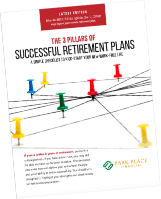Roth Conversions

WHITEPAPER
The 3 Pillars of Successful Retirement Plans
Converting Your IRA for a Better Future
Transferring assets in a Traditional Individual Retirement Account (IRA) or employer-sponsored plan to a Roth IRA may be the most significant strategy for meeting your financial goals. At Park Place Financial, part of our retirement planning services extend to guidance on Roth conversions. Our certified financial planners devote time and effort to thoroughly examining each client’s financial situation, enabling them to deliver personalized solutions for meeting short and long-term retirement goals.
What Is a Roth IRA Conversion?
As mentioned, a conversion occurs when a person shifts assets in a traditional IRA or workplace retirement plan to a Roth IRA. The primary reason for a Roth conversion is to attain tax-free income during retirement.
While people with Roth IRAs pay taxes on pre-tax assets during the year they make the change, future profits will not be taxed. Additionally, withdrawals from the account are tax-free after the holder meets specified requirements.
How Do Conversions Work?
You have multiple options for converting a retirement account into a Roth IRA. Since some are more viable than others, it is important to go over the different strategies you can take with these conversions. The three main approaches include:
- Direct Roth IRA rollover: If you are quitting a job or left a defined-contribution plan behind in a former position, you may consider a direct rollover. In this scenario, the plan manager delivers money to the new account or writes out a check made to the new account for deposit.
- Trustee-to-trustee conversion: This transfer happens when assets in a traditional IRA are moved directly from the trustee, or financial organization, holding it to the trustee where the Roth IRA is held. People can move these accounts to the same financial institution.
- 60-day rollover: With this option, you are paid the assets in the retirement account and then deposit a portion or all of the money into the Roth IRA within 60 days. This conversion method is riskier than the other two because of the time constraints. If you do not deposit the money within that timeframe, it becomes taxable income. You can also incur a 10% tax on early distribution if you are younger than 59 ½. In some cases, the 60-day Roth IRA rollover may result in 10% tax withholding.
Pros and Cons of Roth Conversion
While the tax benefits of converting to a Roth IRA are considerable, whether or not it is a good choice for you relies on numerous factors, including your financial situation, estate planning, and how it will affect your investment portfolio. To determine if this decision makes sense for your needs, consider the advantages and disadvantages of the Roth IRA rollover:
Pros
- Except for earnings, you can access conversion assets for any reason after five years without incurring a penalty.
- The money in your Roth IRA can go towards buying a first-time home for you, your child, or your grandchild without getting taxed. This privilege comes with a $10,000-lifetime limit.
- Depending on how much time you have before retirement, you can amass substantial investment returnsthat may ultimately come out tax-free.
- Roth IRA assets do not have required minimum distributions, meaning they will stay tax-free, provided you do not need the funds when you turn 72.
- Since distributions in a Roth IRA are tax-free, they are not factored into the income threshold that dictates taxes on Medicare Parts B or D premiums, Social Security benefits, or the 3.8% Medicare investment income surtax.
- Eligible withdrawals are income-tax-free for you and any beneficiaries, creating more wealth to pass on to loved ones.
- Assets that lose value do not result in as high a tax bill.
Cons
- Depending on the size of your existing retirement account, the taxes on pre-tax assets when you make the conversion can be steep.
- If you convert to a Roth IRA when you still have money in other retirement accounts, you must calculate how much of the cumulative balances have and have not been taxed. The resulting percentage is considered taxable income.
- The tax rules of managing a Roth IRA can be complex if you are retaining other retirement accounts.
- You have to wait five years to make a withdrawal without facing a penalty—even if you are already 59 ½. This stipulation makes converting to a Roth IRA particularly challenging for younger people.
- Having a Roth IRA may not be as beneficial if your tax rate drops later in your life.
Attain Roth Conversion Planning Services
Roth IRA conversions can be complicated, but you do not need to navigate them alone. At Park Place Financial, our team of certified financial planners has the expertise and tools necessary to help you decide if a Roth IRA rollover will serve your retirement, estate, and other financial objectives.
As an independent financial firm, we adhere to our fiduciary duty to act in the best interest of our clients in all services we provide. Our strategies are backed by validated principles and hard data, giving you confidence that these suggestions will allow you to achieve success. To maintain trustworthy relationships with clients, we keep communication open continuously and deliver timely educational emails to strengthen these connections.
Our goal is to instill hope in clients by creating personalized plans that allow them to attain financial flexibility. You can review our services page to learn more about our solutions or contact us today to schedule a consultation with a Roth conversion planner in Bellaire, Texas.

